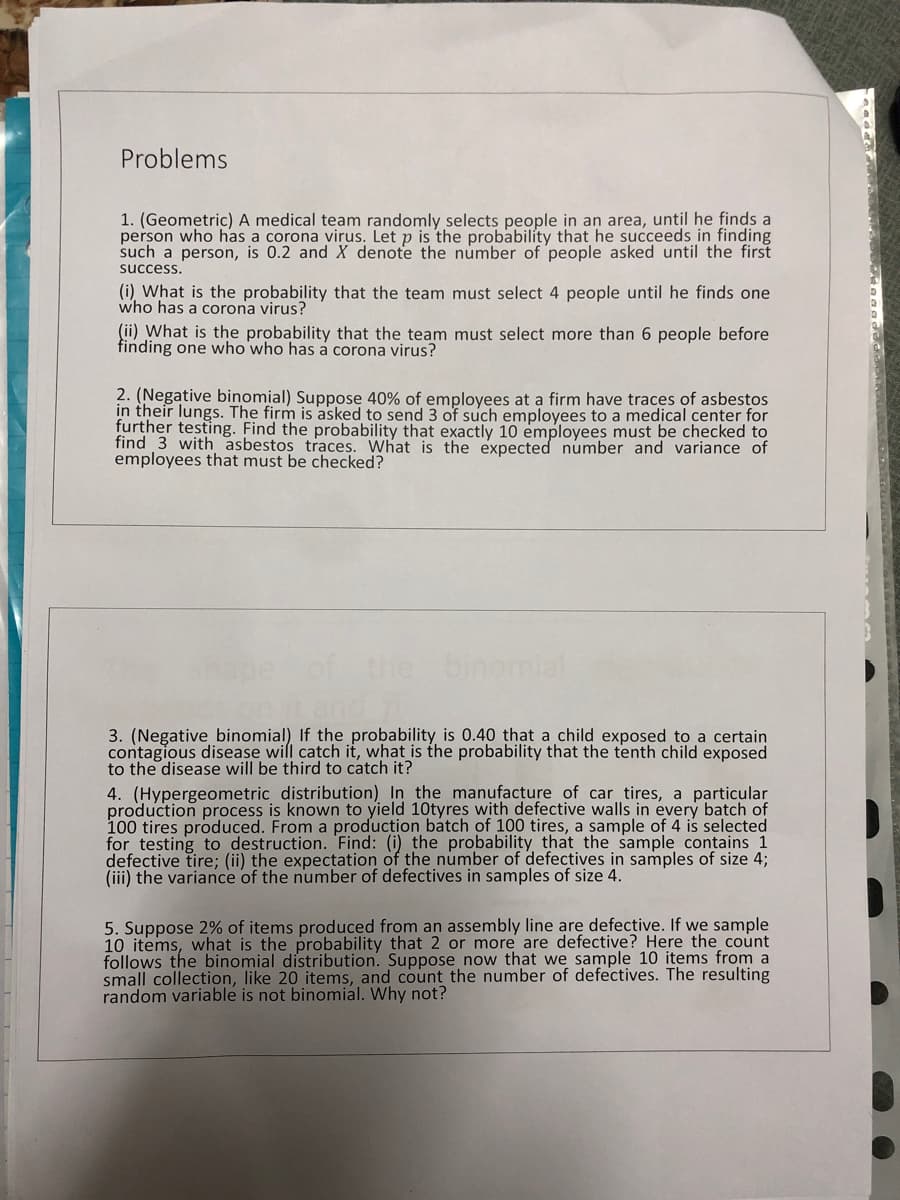1. (Geometric) A medical team randomly selects people in an area, until he finds a person who has a corona virus. Let p is the probability that he succeeds in finding such a person, is 0.2 and X denote the number of people asked until the first success. (i) What is the probability that the team must select 4 people until he finds one who has a corona virus? (ii) What is the probability that the team must select more than 6 people before finding one who who has a corona virus?
1. (Geometric) A medical team randomly selects people in an area, until he finds a person who has a corona virus. Let p is the probability that he succeeds in finding such a person, is 0.2 and X denote the number of people asked until the first success. (i) What is the probability that the team must select 4 people until he finds one who has a corona virus? (ii) What is the probability that the team must select more than 6 people before finding one who who has a corona virus?
MATLAB: An Introduction with Applications
6th Edition
ISBN:9781119256830
Author:Amos Gilat
Publisher:Amos Gilat
Chapter1: Starting With Matlab
Section: Chapter Questions
Problem 1P
Related questions
Question

Transcribed Image Text:Problems
1. (Geometric) A medical team randomly selects people in an area, until he finds a
person who has a corona virus. Let p is the probability that he succeeds in finding
such a person, is 0.2 and X denote the number of people asked until the first
success.
(i) What is the probability that the team must select 4 people until he finds one
who has a corona virus?
(ii) What is the probability that the team must select more than 6 people before
finding one who who has a corona virus?
2. (Negative binomial) Suppose 40% of employees at a firm have traces of asbestos
in their lungs. The firm is asked to send 3 of such employees to a medical center for
further testing. Find the probability that exactly 10 employees must be checked to
find 3 with asbestos traces. What is the expected number and variance of
employees that must be checked?
binomial
3. (Negative binomial) If the probability is 0.40 that a child exposed to a certain
contagious disease will catch it, what is the probability that the tenth child exposed
to the disease will be third to catch it?
4. (Hypergeometric distribution) In the manufacture of car tires, a particular
production process is known to yield 10tyres with defective walls in every batch of
100 tires produced. From a production batch of 100 tires, a sample of 4 is selected
for testing to destruction. Find: (i) the probability that the sample contains 1
defective tire; (ii) the expectation of the number of defectives in samples of size 4;
(iii) the variance of the number of defectives in samples of size 4.
5. Suppose 2% of items produced from an assembly line are defective. If we sample
10 items, what is the probability that 2 or more are defective? Here the count
follows the binomial distribution. Suppose now that we sample 10 items from a
small collection, like 20 items, and count the number of defectives. The resulting
random variable is not binomial. Why not?
Expert Solution
This question has been solved!
Explore an expertly crafted, step-by-step solution for a thorough understanding of key concepts.
Step by step
Solved in 3 steps with 2 images

Recommended textbooks for you

MATLAB: An Introduction with Applications
Statistics
ISBN:
9781119256830
Author:
Amos Gilat
Publisher:
John Wiley & Sons Inc

Probability and Statistics for Engineering and th…
Statistics
ISBN:
9781305251809
Author:
Jay L. Devore
Publisher:
Cengage Learning

Statistics for The Behavioral Sciences (MindTap C…
Statistics
ISBN:
9781305504912
Author:
Frederick J Gravetter, Larry B. Wallnau
Publisher:
Cengage Learning

MATLAB: An Introduction with Applications
Statistics
ISBN:
9781119256830
Author:
Amos Gilat
Publisher:
John Wiley & Sons Inc

Probability and Statistics for Engineering and th…
Statistics
ISBN:
9781305251809
Author:
Jay L. Devore
Publisher:
Cengage Learning

Statistics for The Behavioral Sciences (MindTap C…
Statistics
ISBN:
9781305504912
Author:
Frederick J Gravetter, Larry B. Wallnau
Publisher:
Cengage Learning

Elementary Statistics: Picturing the World (7th E…
Statistics
ISBN:
9780134683416
Author:
Ron Larson, Betsy Farber
Publisher:
PEARSON

The Basic Practice of Statistics
Statistics
ISBN:
9781319042578
Author:
David S. Moore, William I. Notz, Michael A. Fligner
Publisher:
W. H. Freeman

Introduction to the Practice of Statistics
Statistics
ISBN:
9781319013387
Author:
David S. Moore, George P. McCabe, Bruce A. Craig
Publisher:
W. H. Freeman